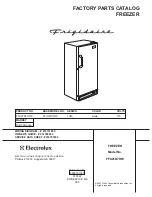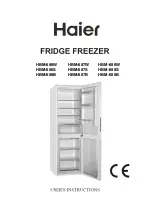
47
1) Always install a new drier every time the sealed refrigeration system is opened. Do not
replace the drier until after all other repair or replacement has been made. Install the
new drier with the arrow on the drier in the direction of the refrigerant flow.
2) Braze all fittings while purging with nitrogen gas flowing at a pressure of 3 to 4 PSIG
Note: Because the pipes in the evaporator case are specially coated to resist corrosion,
it is important to make connections outside the evaporator case when possible. If
it is necessary to braze inside the evaporator case, use sandpaper to remove the
coating from the brazing connections before unbrazing the components.
3) Use an electronic leak detector or soap bubbles to check for leaks. Add a trace of
refrigerant to the system (if using an electronic leak detector), and then raise the
pressure using nitrogen gas (140 PSIG). DO NOT use R-404A or R-134a as a mixture
with pressurized air for leak testing.
3. Evacuation and Recharge
1) Attach a vacuum pump to the system using the low-side access valve.
IMPORTANT
The vacuum level and vacuum pump may be the same as those for current
refrigerants. However, the rubber hose and gauge manifold to be used for
evacuation and refrigerant charge should be exclusively for POE oils.
2) Turn on the vacuum pump. Open the low-side service manifold valve. Never allow the
oil in the vacuum pump to flow backwards.
3) Allow the vacuum pump to pull down to a 29.9" Hg vacuum. Evacuating period depends
on pump capacity.
4) Close the low-side service manifold valve.
5) Turn off the vacuum pump. Disconnect the vacuum pump hose and attach it to a
refrigerant service cylinder. Remember to loosen the connection, and purge the air
from the hose. See the nameplate for the required refrigerant charge. Hoshizaki
recommends only virgin refrigerant or reclaimed refrigerant which meets ARI Standard
No. 700 (latest edition) be used.
6) A liquid charge is required for charging an R-404A system and optional for charging an
R-134a system. Invert the service cylinder and place it on scales. Open the low-side
service manifold valve.
IMPORTANT
In order to prevent compressor damage, use caution in charging large
quantities of liquid into the low side.
7) Allow the system to charge with liquid until the proper charge weight is met.
8) Close the refrigerant service cylinder access valve and disconnect the hose. Close the
service manifold valve and disconnect the low-side hose.
9) Cap the access valve to prevent a possible leak.
Summary of Contents for HUF40A
Page 6: ...6 Units mm in 1a HUR40A D HUF40A D 1 HUR40A HUF40A ...
Page 7: ...7 2 HWR40A HWF40A Units mm in 2a HWR40A D HWF40A D ...
Page 8: ...8 3 HUR68A HUF68A Units mm in 3a HUR68A D HUF68A D ...
Page 9: ...9 4 HWR68A HWF68A Units mm in 4a HWR68A D HWF68A D ...
Page 10: ...10 5 HUR96A 5a HUR96A D Units mm in ...
















































